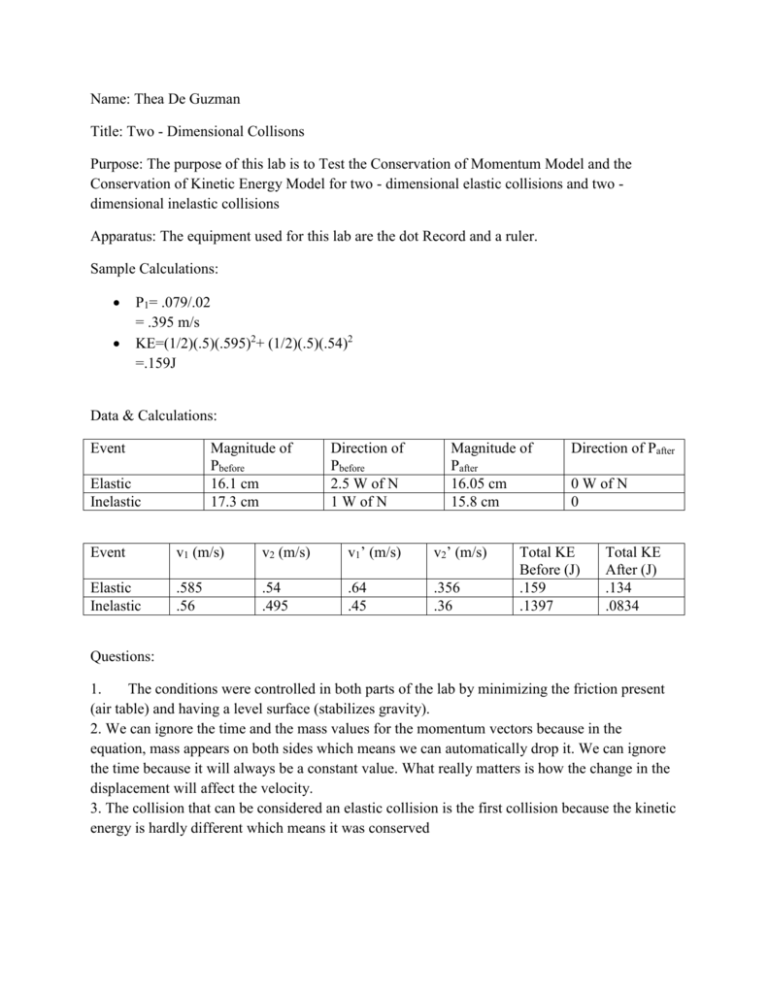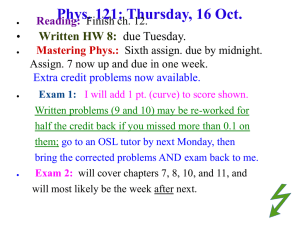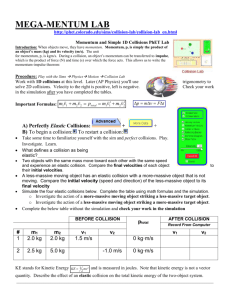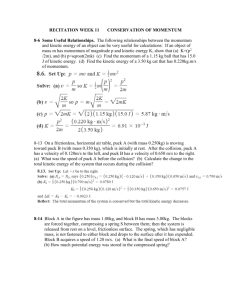2d collision lab - Andea
advertisement

Name: Thea De Guzman Title: Two - Dimensional Collisons Purpose: The purpose of this lab is to Test the Conservation of Momentum Model and the Conservation of Kinetic Energy Model for two - dimensional elastic collisions and two dimensional inelastic collisions Apparatus: The equipment used for this lab are the dot Record and a ruler. Sample Calculations: P1= .079/.02 = .395 m/s KE=(1/2)(.5)(.595)2+ (1/2)(.5)(.54)2 =.159J Data & Calculations: Event Magnitude of Pbefore 16.1 cm 17.3 cm Elastic Inelastic Direction of Pbefore 2.5 W of N 1 W of N Magnitude of Pafter 16.05 cm 15.8 cm Event v1 (m/s) v2 (m/s) v1’ (m/s) v2’ (m/s) Elastic Inelastic .585 .56 .54 .495 .64 .45 .356 .36 Direction of Pafter 0 W of N 0 Total KE Before (J) .159 .1397 Total KE After (J) .134 .0834 Questions: 1. The conditions were controlled in both parts of the lab by minimizing the friction present (air table) and having a level surface (stabilizes gravity). 2. We can ignore the time and the mass values for the momentum vectors because in the equation, mass appears on both sides which means we can automatically drop it. We can ignore the time because it will always be a constant value. What really matters is how the change in the displacement will affect the velocity. 3. The collision that can be considered an elastic collision is the first collision because the kinetic energy is hardly different which means it was conserved Summary: For the first part of this lab we had to test our models for 2D elastic collisions. To do so we first obtained a collision record. We then drew two vectors of five consecutive dots to right before the collision. These were labeled p1 and p2. Using the ruler, we measured the length of each of these vectors. Then we moved one of the vectors to the other in order to create the resultant momentum, Pbefore. We measured and recorded the magnitude of this resultant vector, 16.1 N, along with its direction, West of North. Then, we repeated the steps for each mass after the collision and called the p1’ and p2’. After constructing the resultant vector we recorded its magnitude , 16.05 N, and its direction West of North. We then obtained a collision record for an inelastic collision. We followed the previous steps and found that the magnitude for the Pbefore was 17.3, the magnitude for Pafter was 15.8 and both directions were west of north. In the inelastic collision there was a greater difference between the resultant magnitudes whereas in the elastic collision the magnitudes of the vectors were more similar. For both collisions, however, their directions were the same. Because the differences in magnitude were so slight, it can be said that momentum is conserved. For the next part of the lab we had to find out the kinetic energy values for the before and after of each collision. We first needed to find the velocities of each vector. To do so, we took the magnitude of each vector and divided it by the Δt which was 0.2 seconds. So for v1, the magnitude of p1 was .012 m and we divided that by .02 seconds to get .585 m/s. We repeated these steps for the v1, v2, v1’ and v2’ or both the elastic and inelastic collisions. Next we had to find the total kinetic energy for both the before and after of each collision. We knew that the mass of each puck was 0.5 kg so we plugged our values into the formula KE = (½)(m)(v1)2 + (½)(m)(v2)2 to get the total kinetic energy before of the elastic collision. We repeated these steps for our remaining KE values and recorded them. The first collision can be classified as elastic because the velocities of before and after are closely similar and the total kinetic energy is also more similar than that of the second collision. B. Source of Error are always present in lab and there are three types of error which are human error, systemic error, and assumption error. Human: this could have happened when measuring the length of the vectors. Human: this could have happened when joining the vectors in order to produce the resultant vector. Assumption: this could have happened when assuming that the surface of the collision record was level when the pucks were in motion.










